By D.C. Bloom
(LSM Jan/Feb 2011/vol. 4 – Issue 1)
Lloyd Maines has seen it all over a musical career that’s taken him from Lubbock to London with Joe Ely and most places in-between with Terri Hendrix. But there’s one sight he hopes to never see again. It’s that view from the window seat looking out at his guitar being baggage-mangled on the tarmac below. “I’ve watched baggage handlers toss guitars around like they’re river rocks. It looks like they’re intentionally trying to see how tough the cases are,” says Maines. Sadly, sometimes those hardshells don’t pass the test. “I’ve had the headstocks broken on three guitars,” Maines laments.
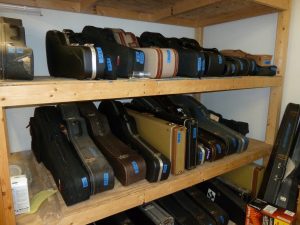
All in a week’s work: Repaired instruments in Ross Jennings’ San Marcos workshop await their return to satisified customers. (Photo by D.C. Bloom)
Other guitar wounds are artist-inflicted. When Austin-based Ramsay Midwood was doing the most basic of domestic chores one afternoon — changing a light bulb — he lost his balance and started to fall, Dagwood Bumstead style. Altering his course mid-air to avoid hitting an amplifier, Midwood landed safely on his feet. But, unfortunately, those same feet had passed straight through his vintage 1953 Silvertone before reaching the floor.
And in the case of 2009 Kerrville New Folk Finalist Tommy Byrd, it was simple operator neglect. Byrd was sitting out on his patio one afternoon when a phone call took him inside. But the guitar was left leaning against a lawn chair outside … overnight. The next morning — after a good ’ol Texas gully washer — Byrd found the water-logged Martin right where he left it … literally becoming unglued. Just like its hapless owner did.
Whether by accident, injury, carelessness, wear and tear, or the unrelenting vagaries of Texas weather, most every guitar in the Lone Star State spends some time up on the shop bench and under the care of a guitar repair person who, hopefully, knows what they’re doing.
This is the story of a few of those who most certainly do know their way around a dreadnought.
They’ve been asked to fix Fenders that have been in floods and fires … Gibsons that have been victims of gunfire … Ovations that have been smashed over someone’s head … Rickenbackers that come into their shops in buckets and Gretchs in garbage bags. They reattach bridges, straighten necks, patch holes and glue together headstocks. They customize instruments for Texas’s working musicians with exacting demands and “we’re leaving tomorrow for the East Coast” touring deadlines. And they restore “wall hangers” for those who just want dear old Grandpa’s old guitar that’s been in the attic for years to regain just a glimmer of the luster it had back in the day so it can be proudly displayed over the mantel.
Every bit as much creativity and passion goes into the repair of an instrument as goes into the music that comes out of it when in the hands of a gifted performer. And like top-of-the-bill performers, a skilled repair person never wants for gigs. Guitarists both famous and unknown, expert and beginner beat well-worn paths to the doors of the best of them, drawn by their hard-earned reputation and the enviable buzz of ringing word-of-mouth recommendations. And, yes, by the mystique and the miracle work many of them do in restoring an instrument that seemed destined for the scrap heap or taking a guitar’s capabilities to greater heights.
***
Jerry Goolsby
“I’ve been accused of being a guitar whisperer,”offers Jerry Goolsby a bit sheepishly. Goolsby, who is a professor of marketing at Loyola University in New Orleans when he’s not bent over a bout or a bridge, honed his guitar repair chops in West Texas while playing in a band where the lead guitarist’s Stratocaster “couldn’t get through a song without going out of tune.” So Goolsby took it home with him after one rehearsal, figured out what was wrong and soon the self-taught fix-it fella was getting other guitars brought to him. Within a few years, he was the manager at the Lubbock Music Center, where regular customers included “the Flatlanders bunch” and Jesse “Guitar” Taylor. The harsh conditions on the Texas plains made it “a treacherous place to have a guitar” offers Goolsby, who notes that wild fluctuations in temperature and humidity, coupled with the fact that “in March, you’d have counties blowing through the air” meant that people who played frequently needed their guitars fine-tuned quite often. Out of town performers at the dearly departed Lubbock nightspot Fat Dawg’s — including an 18-year-old Stevie Ray Vaughn and a pre-Z.Z. Top Billy Gibbons — would also frequently stop in to have Goolsby calibrate and sharpen their axes.
Goolsby bemoans the demise of those independently-owned, old school and downtown music stores and observes that many guitars today are sold through catalogues and over the Internet, or out of suburban chain stores, and as a result, don’t receive the individual attention that he believes is critical. “I don’t remember the last time I got a guitar from somebody that really played well; almost all of them are set up wrong, with bad intonation and the neck out of adjustment,” he says.
He takes the care and feeding of instruments very seriously. “I worship guitars,” Goolsby confesses. “One of the most enriching things in my life is when you hand it back to somebody because it’s their baby.” Based in New Orleans, he worked on many instruments in the wake of Hurricane Katrina. “There were a lot of tears,” he says simply.
For this Lubbock born and bred, Louisania-based repair guru, the chance to both repair and build guitars is “bliss.” And while he acknowledges that the notion of wood that speaks and guitars that whisper back may sound like hokum to some, “it’s absolutely the truth. Sometimes you can pick up a guitar and play it for a while and you can hear what that guitar wants to sound like.
“The guitar’s alive, it’s an organism, and yes, it does want to ‘talk’ to you,” Goolsby says with conviction. “It’s not like repairing an air conditioner.”
***
Elain Fillion
While Tommy Byrd’s guitar was still drying out, a neighbor and fellow New Folk Kerrvert, George Ensle, told him about a hidden gem of a repairperson who lived nearby. There are few former nurses repairing guitars, and even fewer woman who spent two years in a convent who are now doing God’s work on stringed things great and small.
Those are just two of the unique life experiences Elain Fillion brings to the task of guitar repair. Before delving into what is still a male-dominated profession, Fillion also did oil painting, toy making, cabinet building and other crafts. At the suggestion of a friend who told her she had the various skills necessary to do instrument repair work, she thought she’d give it a try. As the daughter of a Canadian musician who’d grown up around guitars and fiddles, doing her first neck repair at the tender age of 8, it seemed like a natural fit. Fillion had also noticed that there were few people who did repairs at the time and those who did were slow, expensive and didn’t do work that was anywhere near the quality she believed she could deliver. So she went to a Salvation Army, bought an old 1950s Stella guitar, brought it home and tore it apart. “I took the top off, worked with the bracing and absolutely fell in love, says Fillion. “I soon realized that an instrument was an art piece until you put the strings on it.”
Diving in head first at a time when there was little literature on repair available meant doing work for free in exchange for the needed experience. Fillion, who was living in the Scottsdale, Ariz., area at the time, found the opportunity in the band rooms of a local school district. “I worked on everything I could get my hands on for two years as a labor of love.” She estimates that over a five-year period she worked on more than 10,000 violas, cellos, and violins.
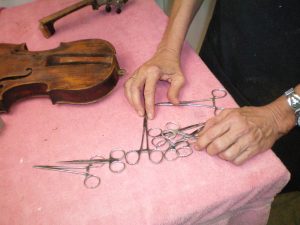
Surgical Precision: Discarded medical tools from Elain Fillion’s nursing years are repurposed to mend fiddles and guitars. (Photo by D.C. Bloom)
But it wasn’t until she did some work for a then unknown Brandi Carlile that Fillion had that Peter-on-the-road-to-Damascus-like epiphany and found “what I really wanted to do when I grew up.” After seeing Carlile, whom Fillion knew only as a painfully shy, monosyllabic teenaged customer of her $5.00 restrung bows, turn into a completely different person as a performer with a fiddle in her hand, she decided to cash in her 401K at the age of 60, purchase the tools she needed to do repair work full-time, and leave the nursing profession behind.
Today, she credits the time management skills she learned as a nurse for helping her manage the steady workload she has from both individual customers and as the repair person serving Guitar Centers in Central Texas. She calls herself an “improviser and a bit of a dumpster diver in seach of things I can use to fix instruments,” a trait she acquired in her time as a toy maker and woodworker. And Fillion says that her years in the convent “living among the Irish fueled a missionary spirit I’ve always had and encouraged me to share by teaching.”
Fillion has currently taken Lana Mills under her wings and has begun to show her the art and craft of guitar repair. Mills is a young musician who had kept asking about coming over to Fillion’s shop to learn at the master’s feet. “I usually don’t like to do it, because it slows you down and costs you money. But she was just so damned persistent,” jokes Fillion. It’s clear that Fillion has found the perfect apprentice in Mills (“She’s a quilter, too, so she kind of fits the bill,” she adds) and they both took pride in a recent repair the young student had done for a satisfied customer who had no idea it was Mills’ maiden attempt at making a guitar saddle.
“I handle instruments like they’re a patient, and I was always patient with my patients, so I’m patient with the people I’m trying to train, too,” Fillion says.
In addition to her way around a bandsaw and a sander, Mills is also learning the importance of bedside manner as it relates to guitar repair. For Fillion, that starts by asking customers to play their instruments “on my couch,” where people open up both musically and with their personal stories. “Some people really tug at my heartstrings,” says Fillion. Recalling one past customer who didn’t share the details of a family tragedy until after the repair work was completed, she says “I did a good job on that guitar, but I wish I’d known his story beforehand, because I maybe would have put a bit more love into it.”
When Byrd, the owner of the soaked Martin, got his guitar back from Fillion, that extra something was evident. “I could really tell it had been in loving hands,” he enthuses, “there was just a new energy about it.”
***
Ross Jennings
In the late 1970s, San Marcos’ Ross Jennings decided he’d had enough of undergraduate life at the University of Texas at Austin, and told his parents he wanted to go to a different institute of higher education. But it wasn’t just any hall of ivy he had his sights set on, it was the Roberto-Venn School of Luthiery in Phoenix, Ariz., then in just its second year of operation. While it has since graduated more than 1,200 guitar builders and repair professionals, Jennings describes those early years as “chaotic and crazy, because they really hadn’t gotten their act together.” But Jennings gravitated to Bill Eaton, who is the school’s current director, and soaked up as much as he could from the noted builder of harp guitars and other multi-stringed instruments. Returning to Central Texas, Jennings went into the guitar-building business with a friend from San Marcos. “But we really weren’t that serious,” he admits. “We worked about half a day and then went swimming.”
So when a friend moved to California, Jennings tagged along and found work at Charvel/Jackson, whose guitars with unique paint jobs and graphics made them the favorites among Los Angeles’ heavy-metal scene hipsters. The factory turned out about 20 instruments a day, with Jennings manning the final stop on the assembly line, where he was responsible for “setting them up, stringing them up, and screwing everything down.” The good ’ol boy from Texas — who was more into the blues — wasn’t phased by and often didn’t recognize the company’s famous clients such as Metallica’s Kirk Hammett, Eddie Van Halen or Steve Vai when they stopped by to talk shop and have their guitars worked on. Jennings says the experience was “a crash course in guitar repair, because there were always all sorts of problems up and down the line.” Ultimately, though, the pressure of meeting daily production quotas didn’t mesh with the young Jennings’ laid-back approach to life.
“Being a bit of a hippie dreamer, I just wanted to have fun,” he says. So when a job opened up at B.C. Rich Guitars, where there was more handmade craftsmanship put into the instruments and far fewer coming off the assembly line, Jennings jumped at the chance. But after a few months on the job, the owner annnounced they were taking production from six-a-day up to the same 20-a-day Jennings had left at Charvel/Jackson. After two years, the burnt-out Jennings hightailed it back to the Lone Star State and — with the considerable guitar building knowledge acquired on the West Coast — once again hung out his shingle in Central Texas and started making and selling Ross Guitars, which he and a partner cranked out at a less stressful rate of about five a month. But over time, the repair work Jennings also did was becoming a much bigger, and far more lucrative, part of the business model. And it wasn’t long before he opted to focus exclusively on repairing instruments.
Today, fellow San Martian Terri Hendrix and her longtime music partner Lloyd Maines are among Jennings’ most loyal customers, with one of Maines’ headstocks on the weekly list of things of do at the moment. Jennings estimates he does upwards of 300-400 repairs annually. “Business is better than ever,” he says, noting that he suspects the weak economy has something to do with folks deciding to have an old reliable maintained and spruced up before they take out the plastic to buy a new custom-built guitar or a top-of-the-line model from a name-brand manufacturer.
But that’s not to say that today’s consumers still don’t have a bit of disposable income they’re willing to expend on some perceived guitar playing edge they just read about on the Internet. “There’s a lot of folklore out there, like if you do this one little mysterious thing with a guitar it’s gonna sound that much better, like brass bridge pins, or that wood binding is so much better than plastic binding. And, the fact is, most of it’s bullshit. And I tell them that. But, if a person insists, I’ll give it to ’em.”
Jennings says he also “gets a phone call every week from some kid wanting to learn how to build and fix guitars.” The advice he gives them? “There’s a lot easier ways to make a living and there’s nothing wrong with chasing your dream … but don’t quit your day job.”
***
Neil Sargent
Houston’s Neil Sargent, also an alum of the Roberto-Venn School of Luthiery, has a self-admitted problem. “I’ll take useless, profitless garbage that no one else will take … and it keeps me poor, “ he confides. “Because I literally waste about half of my time working on crap I shouldn’t even touch, rather than saying ‘No, get that trash out of here!”
Yes, you might say that Sargent has just a wee a bit of that New York City waitress gruffness about him. But even so, it probably hasn’t cost him many customers during his quarter of a century in the guitar repair business. Because just as in those east coast greasy spoons, the attitude is a lot of the appeal So it’s probably kept Houston’s musicians coming back all these years. That, and the simple knowledge that they’re not likely to get a more reasonable quote anywhere else in the city. A little irascibility is a small price to pay when you’re paying a small price.
And the fact is, Sargent hails from Chicago, not Gotham City. That means a more apt analogy would be John Belushi’s “Cheezburger, cheezburger, cheezburger” slinging Greek waiter, who knows exactly what’s best for you well before you’re able to articulate it for yourself. Besides, Sargent can’t keep up that trash talk for long. “Really, I’ll fix most anything and charge a fair price it if I like the job I’m doing.”
Then again, don’t get him started on some of the instruments that find their way through his doors.
“People will bring guitars with strings that are rusty and crusty and I’ll say, ‘What, do you think is okay about this?!’” he marvels. “It’s like walking into a guy’s house and seeing a mess and you think, ‘Dude, the first thing you should do is at least empty the ash trays.’”
But what is more disturbing to Sargent are those customers who are naïve about what a repair person can and can’t do. “Many have really unrealistic cosmetic expectations. They’ll bring in a severely trashed guitar and think, ‘Oh, well, you’re not going to be able to tell when it’s fixed,’ and I’m like ‘Ah, wrong.’”
It’s then that Sargent reminds them that honorable scars are really not such a bad thing. And, of course, with Willie Nelson’s Trigger destined for the Smithsonian someday, there is a certain cache about picking and strumming something that’s seen far better days. “Folkies, in particular, think it’s cool to have this really trashed guitar, and I’m thinking ‘It needs to be rescued from boneheads like you,’” Sargent says.
Even an icon like Nelson isn’t immune from Sargent’s gentle rant: “Willie has worn a hole in the top because he probably didn’t notice,” he jokes. Then, a bit more seriously, he adds, “That’s not really decent stewardship of a guitar.”
Sargent also weighs in on the guitar industry’s equivalent of stone-washed jeans. “There’s this whole line of guitars now that come deliberately beat up. Fender makes a Road Warrior series and before that had a much higher end guitar called Relics that are supposed to look like they’ve been played for 25 years. I’ve spent most of my career trying to fix things and make them look as nice as possible and to see that whole thing reversed in the past 10 years is really kind of mind boggling … You see a guitar with the finish rubbed down from someone having run their thumb up and down the neck a hundred thousand times, well, that’s the way it should be. But to just take sandpaper and create that look seems kind of childish and impatient to me.”
***
Ed Reynods
For Ed Reynolds — repairperson of choice for such guitar legends as Eric Johnson, Redd Volkaert, David Grissom and Monte Montgomery — it’s all about physics … and focus.
“The instrument has to operate within the laws of physics,” Reynolds insists. “The laws of physics cover everything, Science is the first thing I go to, then it’s instincts and really listening with my ears.”
For example, when he was serving as a consultant for Collings Guitars, helping the company develop their electric guitars, Reynolds designed a special test guitar that allowed for a rapid-fire exchange of pickups. “This is a tool used to compensate for the scientific fact that human hearing doesn’t have a lot of memory retention – actually, about 30 seconds worth,” he explains. By being able to change the pickups and play the guitar within that window of time, he’s better able to hear the nuances and subtle characteristics of the equipment. “It’s like having the proper set of barbells to work your arms with,” Reynolds suggests.
Reynolds first started fixing guitars in the early ’70s in his native Chicago. As a guitar player in bands, he, too, was disappointed in the quality of the repairs he’d see from others. “Being mechanically inclined myself, I knew that even on my worst day, I could do a better job.” After practicing on a stash of $5 reject guitars he got from a local wholesaler, he got proficient enough to finally work on his own instruments. Soon, neighborhood musicians were coming to him with minor problems, and the slow transition from band member to master of the repair bench was underway.
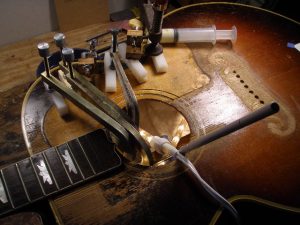
Don’t Think Twice, It’s Alright: A rare ’53 Gibson J-200 under goes intensive care on Ed Reyonld’s work bench. (Courtesy Ed Reynolds)
Helping him along that journey was an elderly German, Steven Ivanovich, who had won the World’s Fair of Musical Instrument Making in Mittenwald, Germany, before World War II. Reynolds remembers his as being “kind of like Obi Wan Kenobi with a hand plane.” And what did the young Jedi learn from Ivanovich while working alongside him? “He gave me the approach that you really have to tune into your instincts and really pay attention. If you really focus, the results come so much quicker and they’re so much more accurate. If you don’t allow yourself to be distracted by anything, you can sense your abilities and go with them.”
There’s also a bit of Obi Wan in Reynolds today. He teaches his customers how to adjust their guitar’s necks and set their own intonation. “I’m a firm believer in empowerment,” he explains. “If you learn how to assess an instrument and the skills necessary to adjust it, you’re going to make better choices in the instrument you buy and you’re going to be able to adjust your instrument to your personal preference.”
Reynolds’s goal, whether a guitar belongs to a professional guitar slinger or a dedicated amateur hobbyist, is the same: to deliver an instrument of optimum capability.
“People come to me for the hard stuff, and that’s how it should be,” says Reynolds. “And I leave them with an instrument that is performing the best it possibly can. I take pride in that. I take joy in that … I’m not the art. I’m the craft.”





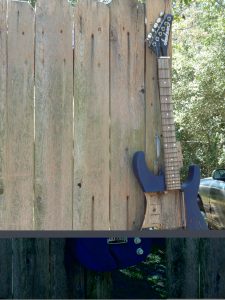
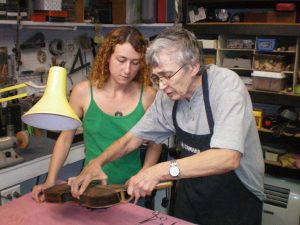
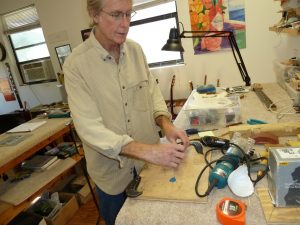
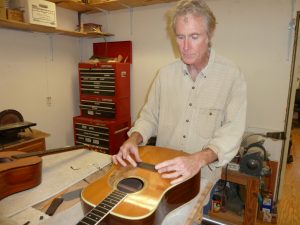
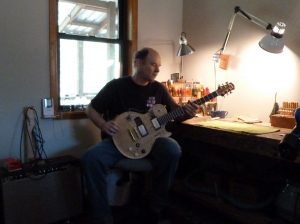

No Comment